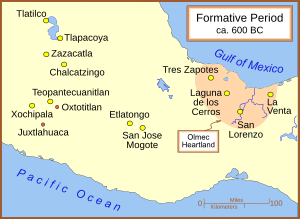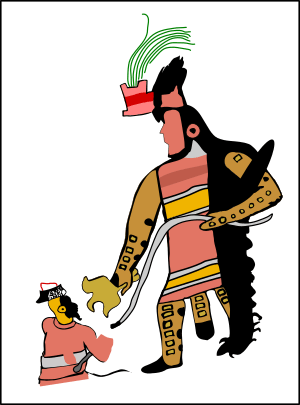Olmec influences on Mesoamerican cultures facts for kids
The Olmec civilization was one of the earliest and most important cultures in ancient Mesoamerica (which is now parts of Mexico and Central America). For a long time, experts have debated how much the Olmecs influenced other cultures in this region. Was the Olmec culture like a "mother" that gave birth to all later cultures, or was it more like a "sister" that grew alongside others? This article explores these ideas.
Contents
Where the Olmecs Lived
Most researchers agree on a few key things about the Olmecs and their home, known as the Olmec heartland:
- The people who became the Olmecs had lived in the Olmec heartland for a very long time. They developed their civilization on their own, without help from other big civilizations.
- The Olmec civilization truly began in this heartland. Their first major city, San Lorenzo Tenochtitlán, became very powerful around 1200 BCE (Before Common Era).
Beyond the Olmec Homeland
Some special features of Olmec culture, like their huge stone heads or large stone altars, are mostly found only in their heartland. However, many Olmec-style objects, designs, and symbols have been found far away. These items show up in archaeological sites hundreds of kilometers (or miles) from the Olmec heartland.
Some of the most important sites showing Olmec influence include:
- Tlatilco and Tlapacoya: These were big centers in the Valley of Mexico. Here, archaeologists found hollow "baby-face" figurines and Olmec designs on pottery.
- Chalcatzingo: Located in the Valley of Morelos, this site has Olmec-style carvings on monuments and natural rock formations.
- Teopantecuanitlan: In Guerrero, this site also features Olmec-style carvings. Its city layout even has special Olmec features.
- San José Mogote: Found in Oaxaca, this site has Olmec-style pottery. Like the larger Olmec city of La Venta, San José Mogote is built facing 8 degrees west of north.
Other places showing Olmec influence are Takalik Abaj and Monte Alto in Guatemala, Las Bocas in Puebla, and Zazacatla. In all these places, archaeologists found Olmec-influenced items mixed with objects made in the local style. Sometimes, Olmec symbols even appeared on objects made by local people, like at Las Bocas.
The Olmec influences found at these distant sites usually appeared after San Lorenzo became important. Also, the ideas and styles mostly traveled from the Olmec heartland to these other places, not the other way around. This one-way flow of ideas has led many experts to call the Olmecs the "mother culture" of Mesoamerica.
The "Mother Culture" Idea
The idea of the Olmecs as a "mother culture" was first formally suggested by Alfonso Caso in 1942. He argued that the Olmecs were the "cultura madre" (mother culture) of Mesoamerica.
People who support the "mother culture" idea don't say that the Olmecs were the only ones who contributed. Instead, they believe the Olmecs were the first to develop many important features that later Mesoamerican civilizations used.
They argue that the special signs of Olmec culture first appeared in San Lorenzo and the Olmec heartland. These signs include the idea of patios and plazas in cities, huge sculptures, Olmec symbols, and special Olmec figurines and art.
The "Sister Culture" Idea
On the other hand, people who support the "sister culture" idea believe that Mesoamerican cultures grew and developed at roughly the same time. Key supporters of this idea, like Joyce Marcus and Kent V. Flannery, argue that the Olmecs were just one important culture among many, not the main source of all cultural change.
They suggest that different groups often competed and shared ideas, which helped new technologies and ways of life spread to all regions. For example, they hint that some Olmec symbols might have actually started in the early Tlatilco culture.
Other researchers, like art historian Caterina Magni, agree with this view. She believes that what we call Olmec culture didn't just start in the Gulf Coast region of Veracruz and Tabasco. Instead, she thinks that Olmec religious and political centers appeared at the same time across a large part of Mesoamerica, from Mexico to Costa Rica. Magni credits these ideas to archaeologist Christine Niederberger Betton.
A Middle Ground Idea
In recent years, a new idea has started to emerge that combines both the "mother" and "sister" culture theories. Archaeologist Christopher Pool suggests that while San Lorenzo was indeed the largest and most developed city in early Mesoamerica, and many key features of Mesoamerican culture first appeared there, the Olmecs might be seen less as a "mother" culture and more like a "father" culture.
This means the Olmec influence mixed with many local traditions, creating unique local styles that had both Olmec and non-Olmec roots. This idea helps explain why the type and amount of Olmec influence can be very different from one place to another in Mesoamerica.
How Olmec Ideas Spread
If Olmec influences mostly flowed out of their heartland, how did this happen? How were Olmec cultural features passed on to sites hundreds of kilometers (or miles) away? Many theories have been suggested, including:
- Olmec military taking over other areas.
- Olmec people moving to and settling in other regions.
- Olmec artists traveling to other cities.
- Missionary work, spreading Olmec beliefs.
- Other towns purposely copying Olmec art styles.
- Long-distance trade by Olmec merchants.
There is not much evidence to support the idea of Olmec military takeovers. Very little Olmec art from that early time shows war or sacrifice. Also, no stone monuments have been found that celebrate rulers' victories, which is different from later cultures like the Maya or ancient Egyptians.
It's also unlikely that Olmec people founded new settlements far from their heartland. Archaeological records show that Olmec-influenced sites already had people living there before the Olmec influence arrived. These sites also have many local objects made in their own traditions. For example, the Tlatilco site has many figurines that are very different from those found in Olmec cities like La Venta or San Lorenzo.
While small, portable art like pottery or tools could have been carried long distances, large monuments like those at Chalcatzingo or Teopantecuanitlan had to be made locally. This means that sculptors and artists who knew Olmec architecture likely traveled to these distant places to create similar ceremonial sites. But this explains how the art was made, not why these distant places wanted Olmec-style art.
Long-Distance Trade
Long-distance trade can explain why Olmec-style objects were found in places like Teopantecuanitlan. It also explains why jade and obsidian (a type of volcanic glass) were found in the Olmec heartland, even though there are no jade or obsidian sources nearby.
However, trade alone doesn't fully explain why Olmec-influenced objects and styles were so widely adopted across Mesoamerica. It also doesn't explain why Olmec symbols appeared on locally made items. Trade can move objects, but it doesn't necessarily move ideas or styles. According to archaeologist Jeffrey Blomster, "we have to move beyond a purely economic model." He suggests that since trade involved pottery with symbols representing Olmec beliefs and religion, something much deeper than just trading goods was happening.
Symbols for Power
To explain why Olmec symbols and ideas were adopted across Mesoamerica, archaeologist F. Kent Reilly suggests that these symbols were used by rising leaders in different towns. These leaders used Olmec styles and symbols, along with the objects themselves, to show their power and importance.
Archaeologist Giselle Canto Aguilera agrees with this idea. At the Zazacatla site in Morelos, she found that the people of Zazacatla started using Olmec styles when their society changed from a simple, equal society to one with different social classes. She explains that "When their society became stratified, the new rulers needed emblems ... to justify their rule over people who used to be their equals." This means the new leaders used Olmec symbols to prove they had the right to rule over others who used to be their equals.
Summary
Olmec-influenced objects are found all over Mesoamerica. Most archaeologists and researchers agree that the Olmecs were not purely a "mother" culture nor just a "sister" culture to other Mesoamerican cultures. Instead, the special Olmec symbols and ideas were first developed in the Olmec heartland. These symbols then became a very widespread art style throughout Mesoamerica.
This style promoted a powerful, unified religion and an "official way of thinking." This way of thinking was adopted by distant local leaders and other important people who wanted to prove and strengthen their claims to power and special status.



